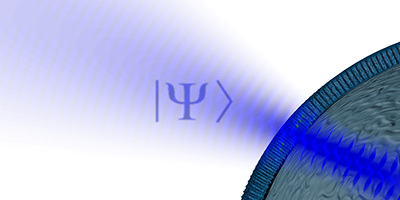February 20, 2014 report
Researchers use squeezed light to enhance photonic force microscopy

(Phys.org) —A team of researchers working in Australia has used "squeezed light" to enhance the sharpness of images produced using photonic force microscopy. In their paper published in Physical Review Letters, the team describes how they applied a property of quantum mechanics to microscopy to offer resolution enhancement of up to 14 percent.
Photonic force microscopy is a type of microscopy where tiny fat granules and light are used to obtain images of objects too small to be seen with other techniques—measurements are taken of the light that is bounced back to create an image. The method suffers, however, when trying to create images beyond its scope—blurriness occurs due to noise from the light source.
Blurriness from a light source occurs because of the nature of photons—they're both wave and particle and as such don't align with one another when traveling. When light strikes a source the photons are all at different points in their wave pattern. This diffraction is what causes the blurriness in microscopy. To get around it, the researchers with this latest effort used a technique where the light was squeezed before striking the object, guaranteeing that all the photons would be aligned.
Squeezing light is based on the Heisenberg uncertainty principle, but instead of trying to deal with measuring the speed or position of a photon at a given point in time, it applies to the same sort of relationship between its phase and intensity. The researchers used this relationship to cause the photons that arrived at a target to all be in the same wave alignment, thus reducing diffraction and the inevitable blurriness that occurs when normal light is used in image creation.
The overall objective of the researchers in this effort was to allow for a better view of the inner workings of living cells—specifically, they'd like to get a view of the pores that exist in cell walls that allow (and prevent) material to pass in and out. Current technology allows for viewing the pores, but only those in dead cells. Photonic force microscopy on the other hand can be used on living cells—thus improving its resolution and helping the researchers achieve their ultimate goal.
More information: Subdiffraction-Limited Quantum Imaging within a Living Cell, Phys. Rev. X 4, 011017 (2014) [7 pages] prx.aps.org/abstract/PRX/v4/i1/e011017
Abstract
We report both subdiffraction-limited quantum metrology and quantum-enhanced spatial resolution for the first time in a biological context. Nanoparticles are tracked with quantum-correlated light as they diffuse through an extended region of a living cell in a quantum-enhanced photonic-force microscope. This allows spatial structure within the cell to be mapped at length scales down to 10 nm. Control experiments in water show a 14% resolution enhancement compared to experiments with coherent light. Our results confirm the long-standing prediction that quantum-correlated light can enhance spatial resolution at the nanoscale and in biology. Combined with state-of-the-art quantum light sources, this technique provides a path towards an order of magnitude improvement in resolution over similar classical imaging techniques.
Journal information: Physical Review Letters , Physical Review X
© 2014 Phys.org





















